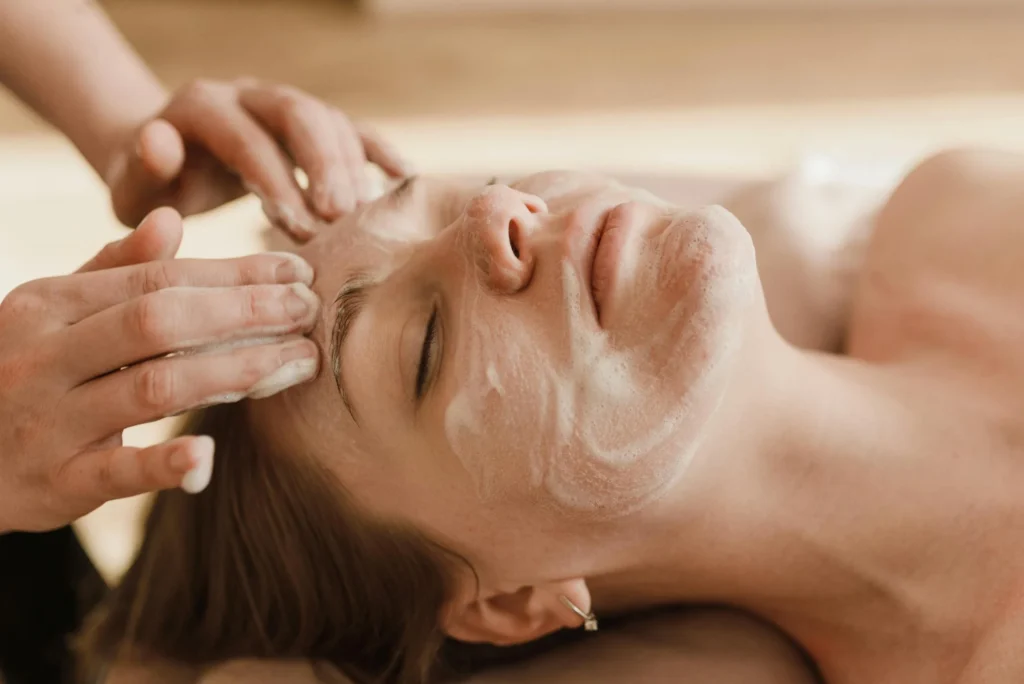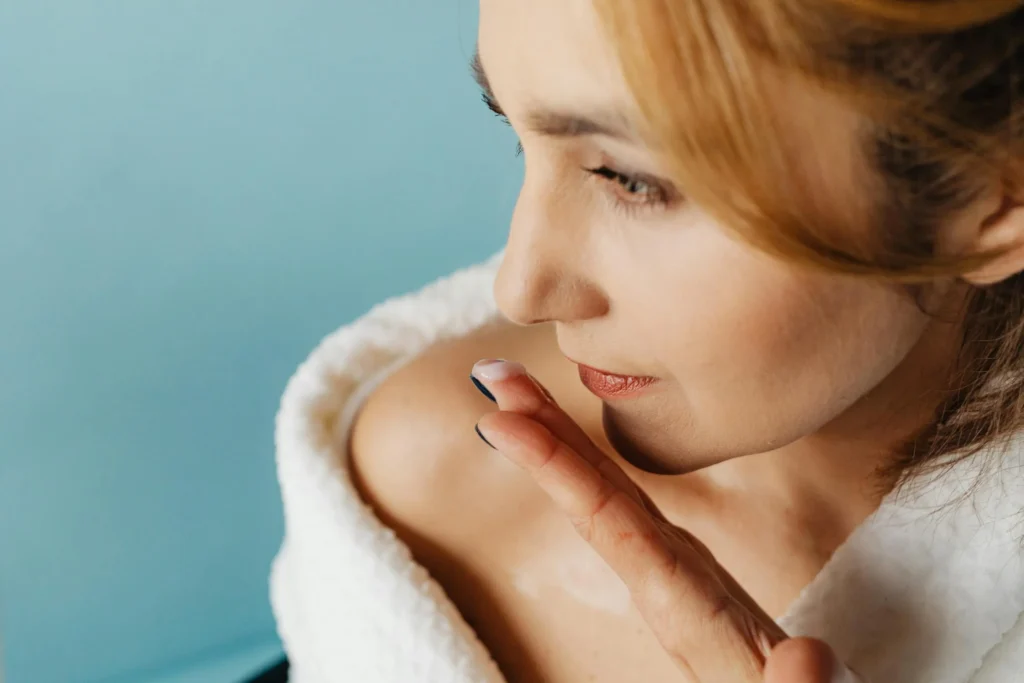
A Layered Transformation
The interplay between hormones and the body’s largest organ—skin—is a fascinating topic, yet it is often overlooked. During the phases leading to and following menopause, the skin experiences changes that reflect the complex biological shifts within. The loss of elasticity, an unmistakable hallmark of ageing, is often exacerbated by the natural decline in estrogen. This hormone, while renowned for its reproductive functions, also plays a pivotal role in maintaining the structural integrity of skin tissues.

- Hormone replacement therapy (HRT), introduced as a solution for alleviating the discomforts of menopause, offers additional benefits beyond its primary purpose.
- Among these advantages, its connection to skin elasticity has drawn increasing attention from dermatologists and patients alike.
- The changes witnessed in skin treated with HRT are not merely superficial. Instead, they underscore the intricate relationship between internal equilibrium and outward appearance.
Elasticity, the skin’s ability to bounce back after stretching or compression, diminishes as collagen production slows. Coupled with the weakening of elastin fibers, this process leads to visible sagging and thinning. These changes are not simply cosmetic concerns; they carry emotional and psychological weight, especially for individuals grappling with the multifaceted challenges of aging. HRT, by supplementing the body’s hormonal deficits, addresses these shifts at their core, providing a pathway to renewal.
The Science Beneath the Surface
The skin, while appearing uniform, consists of layers with distinct roles in preserving its strength and elasticity. Estrogen exerts significant influence over the dermis, where fibroblasts produce collagen and elastin. These proteins form the framework of youthful, resilient skin. Without sufficient hormonal support, fibroblast activity wanes, and the once-firm matrix begins to weaken.

HRT introduces synthetic or bioidentical hormones that replenish declining estrogen levels. By binding to receptors in the dermal layers, these hormones stimulate collagen synthesis and enhance water retention. Increased hydration amplifies skin’s suppleness, counteracting the dryness and fragility that often accompany menopause. This process not only reinforces the skin’s physical structure but also restores its inherent radiance, which tends to fade with age.
Estrogen and the Skin of the Face
Facial skin, constantly exposed to environmental stressors, undergoes significant changes during menopause. The decline in estrogen directly impacts facial elasticity, leading to sagging around the jawline, cheeks, and eyes. Collagen loss accelerates, and the depletion of hyaluronic acid—a substance crucial for maintaining hydration—contributes to a dull, uneven appearance. Fine lines deepen, and the once-plump skin of the cheeks may appear hollowed.

- Estrogen plays an essential role in maintaining the firmness and glow of facial skin by supporting vascular health.
- The microcirculation beneath the surface ensures oxygen and nutrients reach the skin, preserving its vitality.
- As estrogen levels drop, this circulation diminishes, leaving skin more prone to dryness and slower healing.
- HRT, particularly with formulations targeting estrogen deficiencies, can rejuvenate facial skin.
- Estrogen therapy helps reduce wrinkles
- Improve overall texture by restoring moisture, improving collagen density, and stimulating blood flow.
These changes not only enhance physical appearance but also boost confidence, especially for those who see their face as a reflection of their well-being.
The Role of Estriol Cream
Among various HRT options, estriol cream has gained recognition for its targeted benefits to facial skin. Estriol, one of the three primary forms of estrogen, is known for its mild yet effective action. Unlike estradiol, which has a more systemic impact, estriol acts predominantly on local tissues, making it an ideal choice for topical applications.

Estriol face cream works by binding to estrogen receptors in the skin, activating processes that stimulate collagen production and hydration. Users often notice improvements in fine lines, enhanced elasticity, and a more even complexion. Because estriol has a lower potency compared to other estrogens, it carries a reduced risk of side effects while still delivering noticeable results.
The cream also supports the restoration of the skin’s natural barrier, which can become compromised with age. A stronger barrier reduces water loss, protecting the skin from environmental aggressors such as pollution and UV radiation. Over time, regular use of estriol cream contributes to smoother, firmer, and healthier-looking skin.
A Personal Perspective on Aging Gracefully
The journey through menopause is profoundly personal, marked by physical transitions and emotional reflections. While the body undergoes inevitable changes, the visible alterations in the skin often evoke a deeper response. Wrinkles, sagging, and dullness serve as constant reminders of time’s passage, which can feel disheartening. A sense of control, however, emerges when individuals explore solutions like HRT.

For many, the decision to pursue hormone replacement therapy involves careful deliberation. It is not solely about addressing surface-level concerns but about embracing a holistic approach to wellness. Improved elasticity represents more than a cosmetic benefit; it symbolizes resilience, both of the skin and the spirit. Observing these changes fosters renewed confidence, encouraging individuals to view aging as an evolution rather than a decline.
It is crucial to acknowledge that the efficacy of HRT varies among individuals, influenced by genetics, lifestyle, and overall health. The degree of improvement in elasticity depends on these factors, alongside the specific type and dosage of hormones used. Personalized consultation with knowledgeable practitioners ensures that expectations align with achievable outcomes, maximizing both safety and satisfaction.
The Broader Implications of Hormonal Health
The impact of estrogen on the skin highlights the interconnectedness of the body’s systems. Beyond its visible effects, HRT serves as a reminder of how hormonal balance shapes overall health. Strengthened skin integrity contributes to its function as a protective barrier, reducing susceptibility to environmental stressors and infections.

- Skin elasticity also intertwines with psychological well-being.
- Feeling comfortable in one’s appearance fosters self-esteem, which profoundly influences how individuals navigate social interactions and personal relationships.
- The emotional boost derived from improved skin often complements the physical relief HRT provides, creating a multifaceted sense of renewal.
As research continues to explore the long-term effects of hormone therapy, the findings reinforce the importance of informed decision-making. While the connection between HRT and skin elasticity is compelling, potential risks must be weighed alongside benefits. Open discussions with medical professionals help individuals make choices that reflect their unique circumstances and priorities.
Embracing the Complexity of Change
Aging is neither a linear process nor a uniform experience. It unfolds in layers, each revealing aspects of beauty, strength, and vulnerability. The connection between HRT and skin elasticity illustrates the nuanced interplay of science, health, and identity. By addressing the hormonal foundations of elasticity, HRT offers not just a solution but a testament to the intricate mechanisms that sustain vitality.

Reflecting on these dynamics invites a broader appreciation for the body’s adaptability. While the visible changes of aging may evoke mixed emotions, they also serve as reminders of life’s depth and progression. Hormone replacement therapy, when approached thoughtfully, supports this journey by nurturing the skin’s elasticity and, by extension, the individual’s sense of self.
In celebrating these transformations, one finds not a reversal of time but a harmonious acceptance of its passage. Skin, as a mirror of internal health, reflects the power of balance, resilience, and care—qualities that define not only its elasticity but also the spirit it protects.
